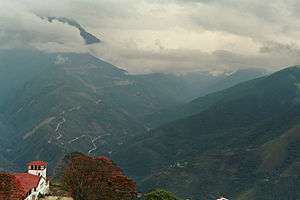Yungas Road

The North Yungas Road (also known as Grove's Road, Coroico Road, Camino de las Yungas, Death Road, Road of death or Road of fate) is a road leading from La Paz to Coroico, 56 kilometres (35 mi) northeast of La Paz in the Yungas region of Bolivia. In 1995 the Inter-American Development Bank christened it as the "world's most dangerous road".[1][2][3] In 2006, one estimate stated that 200 to 300 travellers were killed yearly along the road.[3] The road includes cross markings on many of the spots where vehicles have fallen.
The South Yungas Road connects La Paz to Chulumani, 64 kilometres (40 mi) east of La Paz, and is considered to be nearly as dangerous as the North Road.[4]
Route description
This is one of the few routes that connects the Yungas region of northern Bolivia to the capital city. Upon leaving La Paz, the road first ascends to around 4,650 metres (15,260 ft) at La Cumbre Pass, before descending to 1,200 metres (3,900 ft) at the town of Coroico, transiting quickly from cool Altiplano terrain to rainforest as it winds through very steep hillsides and atop cliffs.
The largely single-lane road has few guard rails and cliffs of up to 600 metres (2,000 feet). Most of the road is the width of a single vehicle, about 3.2 metres (10 ft). During the rainy season from November to March, rain and fog can severely hamper visibility, and water runoff can turn the road into a muddy track, affecting traction. In the summer, rockfalls are common and vehicle dust limits visibility as well.[5]
One of the local road rules specifies that the downhill driver never has the right of way and must move to the outer edge of the road. This forces the faster downhill vehicle to stop so that passing can be negotiated safely. Unlike the rest of Bolivia, vehicles are required to drive on the left side of the road to give the driver a better view of the vehicle's outside wheel and making passing safer.
Attraction
The danger of the road made it a popular tourist destination starting in the 1990s, drawing some 25,000 thrillseekers.[6] Mountain biking enthusiasts in particular have made it a favourite destination for downhill biking since there is a 64-kilometre (40 mi) stretch of continuous downhill riding with only one short uphill section. There are now many tour operators catering to this activity, providing information, guides, transport and equipment.[5]
Nevertheless, the Yungas Road remains dangerous. At least 18 cyclists have died on the road since 1998.[7]
It was featured on the BBC show Top Gear: Bolivia Special (Episode 6 of Top Gear series 14) where the hosts travelled 1,610 kilometres (1,000 mi) from the Bolivian rainforest to the Pacific Ocean.[8][9][10] The road began to crumble under the wheels of Jeremy Clarkson's Range Rover, as he was forced to the edge while passing another vehicle.[11]
A Mitsubishi Outlander TV commercial was the first ever filmed on the road.[12]
The second season of IRT: Deadliest Roads, a spin-off of the History Channel series Ice Road Truckers, follows six North American drivers as they haul cargo along the road.
The road featured in the third episode of Hamish and Andy's Gap Year South America on Australia's Nine Network in 2014.
The road also featured on the BBC show World's Most Dangerous Roads in series three, episode three. The episode starred Phill Jupitus and Marcus Brigstocke and first aired Wednesday 9 January 2013 on BBC HD.[13]
History

The road was built in the 1930s during the Chaco War by Paraguayan prisoners.
The Yungas Road was modernized during a 20-year period ending in 2006. The modernization included enlarging the carriageway from one to two lanes, constructing asphalt pavement, and building a new section between Chusquipata and Yolosa, bypassing to the north one of the most dangerous sections of the old 'Death Road'.
This new route features modern construction (bridges, drainage, etc.), multiple lanes, pavement, guardrails and many other elements that make it considerably safer than the original route. The original North Yungas Road is currently much less used by traffic, although an increasing number of adventure travellers bike it.
In popular culture
The graphic novel adventure Tintin and The Broken Ear contains a car chase down a road based on the Yungas Road.[14]
See also
| Wikimedia Commons has media related to Yungas Road. |
References
- ↑ Chang, Richard S. (8 February 2010). "The Most Dangerous Road?". Wheels.blogs.nytimes.com. Retrieved 6 November 2011.
- ↑ "The Most Dangerous Roads in the World". Darkroastedblend.com. 11 November 2006. Retrieved 6 November 2011.
- 1 2 Whitaker, Mark (11 November 2006). "The world's most dangerous road" (Podcast). BBC. Retrieved 10 May 2007.
- ↑ "Driving Bolivia's Road of Death". Lonely Planet. 12 November 2010. Retrieved 1 March 2011.
- 1 2 Branswell, Jack (29 March 2008), "Madness, but a thrill", Ottawa Citizen, retrieved 23 November 2011
- ↑ Mostrous, Alexi (25 April 2008). "British cyclist Tom Austin killed on Bolivian 'Highway of Death'". The Times. London. Retrieved 25 April 2008.
- ↑ Geoghegan, Tom (16 May 2010). "Cycling the world's most dangerous road". BBC News Online. Retrieved 16 May 2010.
- ↑ TopGear BOLIVIA SEASON: 14 EPISODE: 6. BBCAmerica.
- ↑ Top Gear, Bolivia Special. BBC
- ↑ Road of Death – Yungas, Bolivia
- ↑ Top Gear: Bolivia's Death Road BBC. A 7+ minute YouTube clip shows part of the show including the road beginning to crumble at the 7:00 min mark.
- ↑ Tone, Debra (24 May 2011). "Mitsubishi Outlander Conquers Infamous 'Road of Death'". Send2press Newswire. Retrieved 9 August 2011.
- ↑ http://www.bbc.co.uk/programmes/b01pw3yx
- ↑ "The Broken Ear".
External links
- BBC News – The world's most dangerous road
- Photos and first-person video taken while driving the Yungas Road, November 2010
Coordinates: 16°20′09.26″S 68°02′25.78″W / 16.3359056°S 68.0404944°W